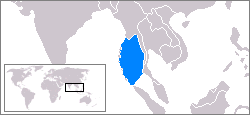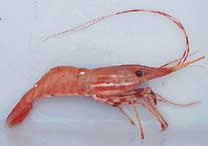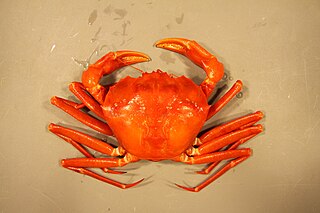
The Andaman Sea is a marginal sea of the northeastern Indian Ocean bounded by the coastlines of Myanmar and Thailand along the Gulf of Martaban and west side of the Malay Peninsula, and separated from the Bay of Bengal to its west by the Andaman Islands and the Nicobar Islands. Its southern end is at Breueh Island just north of Sumatra, with the Strait of Malacca further southeast.

The Indian prawn is one of the major commercial prawn species of the world. It is found in the Indo-West Pacific from eastern and south-eastern Africa, through India, Malaysia and Indonesia to southern China and northern Australia. Adult shrimp grow to a length of about 22 cm (9 in) and live on the seabed to depths of about 90 m (300 ft). The early developmental stages take place in the sea before the larvae move into estuaries. They return to the sea as sub-adults.

Pandalus borealis is a species of caridean shrimp found in cold parts of the northern Atlantic and northern Pacific Oceans, although the latter population now often is regarded as a separate species, P. eous. The Food and Agriculture Organization refers to them as the northern prawn. Other common names include pink shrimp, deepwater prawn, deep-sea prawn, Nordic shrimp, great northern prawn, northern shrimp, coldwater prawn and Maine shrimp.

The bristly catshark is a cat shark of the family Scyliorhinidae, found from southeastern India and the Andaman Islands, between latitudes 15° N and 5° N, at depths between 200 and 300 m. Its length usually ranges from around 20–26 cm, and it is regarded as the smallest catshark of Bythaelurus.

Pandalus platyceros, also called California spot prawn or Alaskan prawn, is a shrimp of the genus Pandalus.

The habitat of deep-water corals, also known as cold-water corals, extends to deeper, darker parts of the oceans than tropical corals, ranging from near the surface to the abyss, beyond 2,000 metres (6,600 ft) where water temperatures may be as cold as 4 °C (39 °F). Deep-water corals belong to the Phylum Cnidaria and are most often stony corals, but also include black and thorny corals and soft corals including the Gorgonians. Like tropical corals, they provide habitat to other species, but deep-water corals do not require zooxanthellae to survive.

The lesser electric ray, also known as the Brazilian electric ray, small electric ray, spotted torpedo ray, torpedofish or trembler, is a species of numbfish in the family Narcinidae found on the western coastal fringes of the Atlantic Ocean and Caribbean Sea. It is a small slow-moving fish, living in the surf zone of sandy or muddy beaches. Here it is easily caught as bycatch by shrimp fisheries and seine netters. The International Union for Conservation of Nature has rated it as being of "least concern".

Metapenaeus monoceros is a species of prawn in the family Penaeidae. It is also known as speckled shrimp, brown shrimp and pink shrimp in English, crevette mouchetée in French, camarón moteado in Spanish, koraney chingri or honye chingri in India, ginger prawn in South Africa and choodan chemmeen in Malayalam.

Sepia prashadi, common name hooded cuttlefish, is a widely distributed species of cuttlefish. It has a thin, oval body and grows from 5 to 11 cm. The tips of the tentacles have a distinct club shape. S. prashadi is a migratory, demersal cuttlefish living in shallow waters at depths of approximately 40 to 50 metres. It is found in many locations including the east coast of Africa, around India, in the Red Sea, and Persian Gulf.

Chaceon quinquedens, commonly known as the red deep-sea crab, but sold as Atlantic deep sea red crab, or simply Atlantic red crab or red crab is a crab that lives in the Atlantic Ocean off the East Coast of the United States and Canada, from North Carolina to Nova Scotia.

Brotula barbata, commonly known as the bearded brotula, Atlantic bearded brotula, or sugarfish, is a species of cusk-eel in the genus Brotula. It lives in the Atlantic Ocean, in depths of up to 300 meters. Its coloring ranges from olive-brown to red-brown, and it grows up to be around 50 centimeters. It has a carnivorous diet, and it is oviparous.

Solenoceridae is a family of decapods, containing 10 genera. Members of this family are marine, inhabiting shallow and offshore waters from the mid-continental shelf, ranging from depths to 1000 meters deep. Members of this family are also sometimes confused with other commercial shrimp species.

Solenocera is a genus of prawns in the family Solenoceridae. Solenocera occur from 0 to 2,067 meters deep in the ocean.

Pinna bicolor, also known as razorfish, razor clam, or pen shell, is a species of large saltwater clam in the family Pinnidae. It is commonly found in shallow waters up to 50 m (160 ft) deep. It can be found embedded in firm muddy intertidal sediments, seagrass beds, and reef flats along continental and island shores.

The Guianan marine ecoregion stretches along the middle of the northeast coast of South America, touching Venezuela, Guyana, Suriname and French Guiana. It extends about 200 miles offshore, with the warm Guianan Current moving east-to-west through the region. This current brings in fresh, turbid waters from the mouth of the Amazon River to the east. As the current exits the ecoregion to the west it contributes an estimated 70% of the waters of the Caribbean Sea. A very large oil field has been recently discovered in the Guyana-Suriname Basin of the ecoregion. The Guianan is one of two ecoregions in the North Brazil Shelf province, a Large marine ecosystem (LME). The Guianan is thus part of the larger Tropical Atlantic realm.
Chirodactylus jessicalenorum, the natal fingerfin, is a species of ray-finned fish within the family Cheilodactylidae. It is found in the Indian Ocean off the coast of South Africa, at depths of 3 to 20 meters below sea level.
The ornate numbfish is a species of electric ray within the family Narcinidae. It is endemic to northern Australia, inhabiting waters in the Timor and Arafura Seas near Cape Londonberry, The Kimberley, Western Australia, and the western side of Cape York. It is a benthic species, found on continental shelves at depths of 48 to 132 meters below sea level.

Selene orstedii, the Mexican moonfish, is a species of ray-finned fish within the family Carangidae. The species is found in the eastern Pacific Ocean, off the coasts of Baja California, Mexico to Ecuador. It grows to a max length of 33 centimeters, but is more commonly found at 25 centimeters in length. Adults are found in shallow coastal waters at depths up to 50 meters below sea level, usually near the seafloor. Its diet consist of squid, small crabs, small fishes and polychaetes.

Palinurus gilchristi, the southern spiny lobster, is a species of spiny lobster within the family Palinuridae.
Solenocera alfonso is a species of decapod within the family Solenoceridae. The species is found in the eastern Indian Ocean and western central Pacific Ocean near countries such as the Philippines, Indonesia, and Australia at depths of 176 to 547 meters near benthic environments. It grows to lengths of 4 to 12 centimeters.
















